
Binomial Theorem Proof and Examples
The binomial theorem is an equation that tells us how to develop an expression of the form (a + b)n for some natural number n. A binomial is nothing more than the sum of two elements, like (a + b). It also allows us to know for a term given by akbn-k what is the coefficient that accompanies it.
This theorem is commonly attributed to the English inventor, physicist and mathematician Sir Isaac Newton; However, various records have been found that indicate that its existence was already known in the Middle East, around the year 1000.
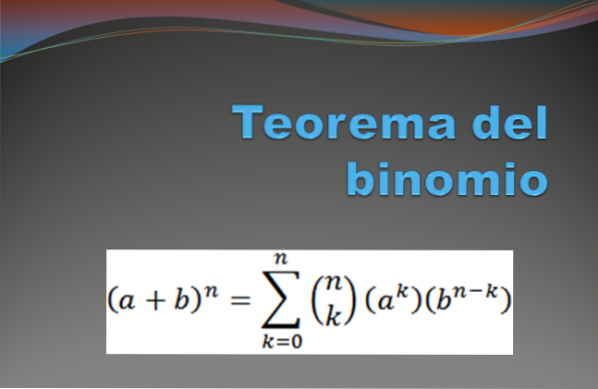
Article index
- 1 Combinatorial numbers
- 2 Demo
- 3 Examples
- 3.1 Identity 1
- 3.2 Identity 2
- 4 Another demonstration
- 4.1 Proof by induction
- 5 Curiosities
- 6 References
Combinatorial numbers
The binomial theorem tells us mathematically the following:
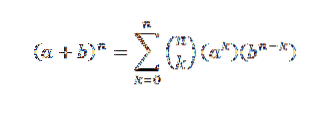
In this expression a and b are real numbers and n is a natural number.
Before giving the demo, let's look at some basic concepts that are necessary.
The combinatorial number or combinations of n in k is expressed as follows:

This form expresses the value of how many subsets with k elements can be chosen from a set of n elements. Its algebraic expression is given by:

Let's see an example: suppose we have a group of seven balls, of which two are red and the rest are blue..

We want to know how many ways we can arrange them in a row. One way could be to place the two reds in the first and second positions, and the rest of the balls in the remaining positions..

Similar to the previous case, we could give the red balls the first and last position respectively, and occupy the others with blue balls.

Now an efficient way to count how many ways we can arrange the balls in a row is by using combinatorial numbers. We can see each position as an element of the following set:

Then it only remains to choose a subset of two elements, in which each of these elements represents the position that the red balls will occupy. We can make this choice according to the relationship given by:

In this way, we have that there are 21 ways to order these balls.
The general idea of this example will be very useful in proving the binomial theorem. Let's look at a particular case: if n = 4, we have (a + b)4, which is nothing more than:

When we develop this product, we are left with the sum of the terms obtained by multiplying one element of each of the four factors (a + b). Thus, we will have terms that will be of the form:

If we wanted to obtain the term from the form a4, just multiply as follows:
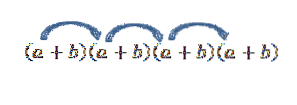
Note that there is only one way to obtain this element; but, what happens if we now look for the term of the form atwobtwo? Since “a” and “b” are real numbers and, therefore, the commutative law is valid, we have that one way to obtain this term is to multiply with the members as indicated by the arrows.
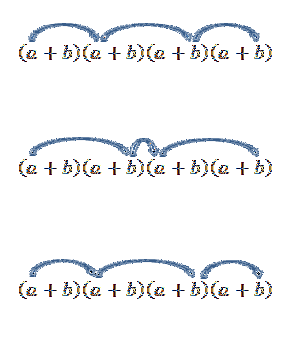
Performing all these operations is usually somewhat tedious, but if we see the term "a" as a combination where we want to know how many ways we can choose two "a" from a set of four factors, we can use the idea from the previous example. So, we have the following:

Thus, we know that in the final expansion of the expression (a + b)4 we will have exactly 6atwobtwo. Using the same idea for the other elements, you have to:
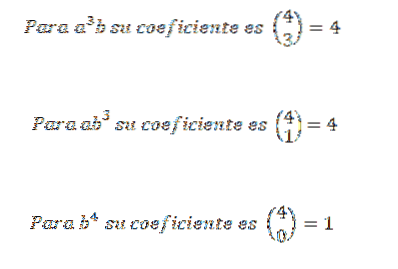
Then we add the expressions obtained previously and we have that:

It is a formal proof for the general case in which "n" is any natural number.
Demonstration
Note that the terms that remain when developing (a + b)n They are of the form akbn-k, where k = 0,1,…, n. Using the idea of the previous example, we have the way to choose "k" variables "a" of the "n" factors is:

By choosing in this way, we are automatically choosing n-k variables "b". From this it follows that:

Examples
Considering (a + b)5, What would your development be?
By the binomial theorem we have:

The binomial theorem is very useful if we have an expression in which we want to know what the coefficient of a specific term is without having to do the full expansion. As an example we can take the following unknown: what is the coefficient of x7Y9 in the expansion of (x + y)16?
By the binomial theorem, we have that the coefficient is:
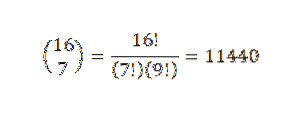
Another example would be: what is the coefficient of x5Y8 in the development of (3x-7y)13?
First we rewrite the expression in a convenient way; this is:

Then, using the binomial theorem, we have that the coefficient sought is when we have k = 5
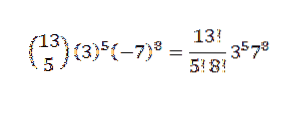
Another example of the uses of this theorem is in the proof of some common identities, such as those that we will mention below.
Identity 1
If "n" is a natural number, we have:
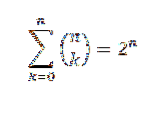
For the proof we use the binomial theorem, where both "a" and "b" take the value of 1. Then we have:

In this way we have proven the first identity.
Identity 2
If "n" is a natural number, then
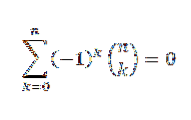
By the binomial theorem we have:

Another demonstration
We can make a different proof for the binomial theorem using the inductive method and Pascal's identity, which tells us that, if “n” and “k” are positive integers that satisfy n ≥ k, then:
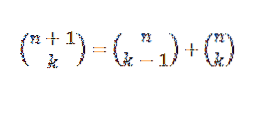
Induction proof
Let's first see that the inductive base holds. If n = 1, we have:

Indeed, we see that it is fulfilled. Now, let n = j such that:
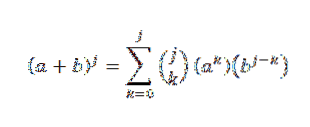
We want to see that for n = j + 1 it is true that:
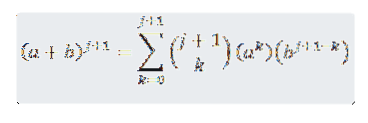
So we have to:

By hypothesis we know that:
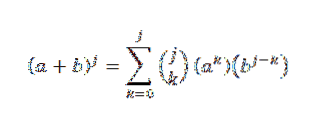
Then, using the distributive property:

Subsequently, developing each of the summations, we have:

Now, if we group in a convenient way, we have that:
Using the identity of pascal, we have:

Finally, note that:

Therefore, we see that the binomial theorem holds for all "n" belonging to the natural numbers, and with this the proof ends.
Curiosities
The combinatorial number (nk) is also called the binomial coefficient because it is precisely the coefficient that appears in the development of the binomial (a + b)n.
Isaac Newton gave a generalization of this theorem for the case in which the exponent is a real number; this theorem is known as Newton's binomial theorem.
Already in ancient times this result was known for the particular case in which n = 2. This case is mentioned in the Elements by Euclid.
References
- Johnsonbaugh Richard. Discrete mathematics. PHH
- Kenneth.H. Rosen. Discrete Mathematics and its Applications. S.A. MCGRAW-HILL / INTERAMERICANA DE ESPAÑA.
- Seymour Lipschutz Ph.D & Marc Lipson. Discrete Mathematics. McGRAW-HILL.
- Ralph P. Grimaldi. Discrete Mathematics and Combinatorics. Addison-Wesley Iberoamericana
- Verde Star Luis… Discrete and Combinatorial Mathematics.Anthropos



Yet No Comments